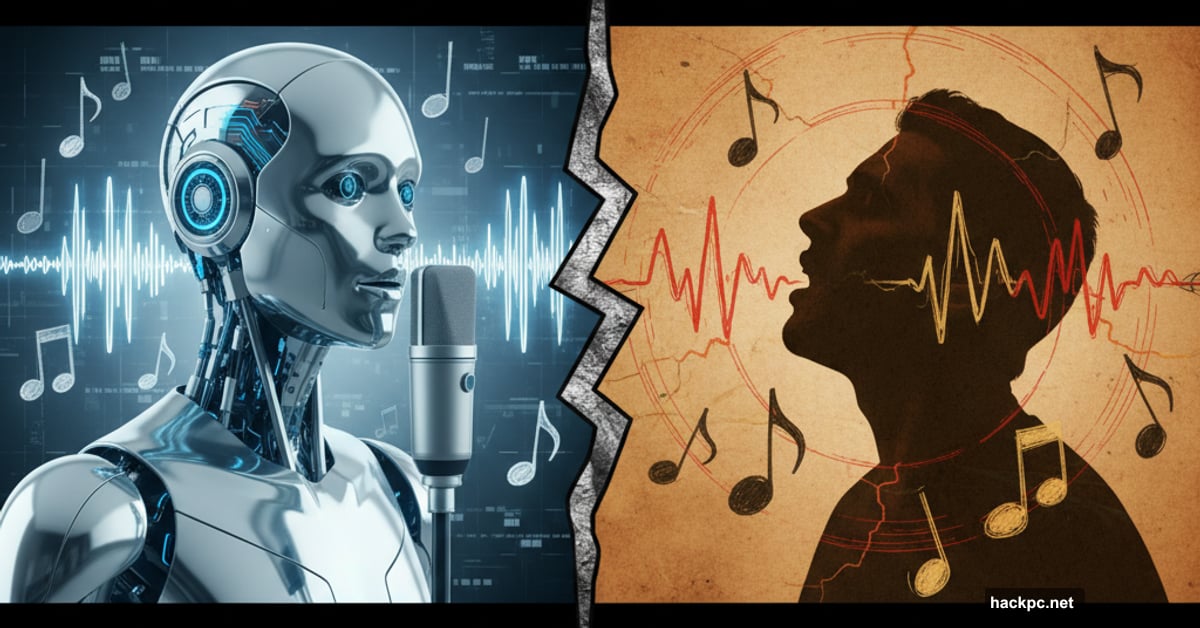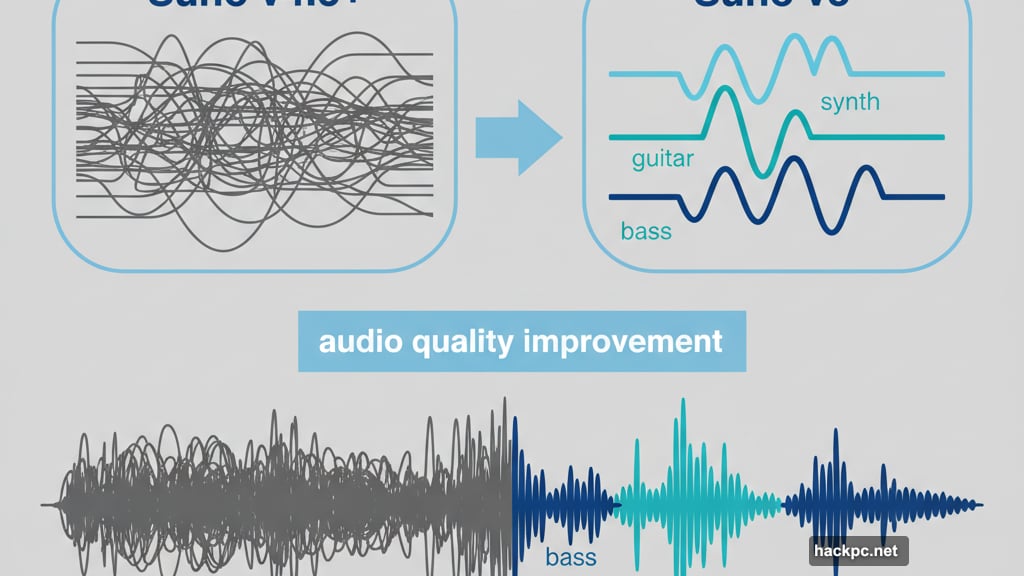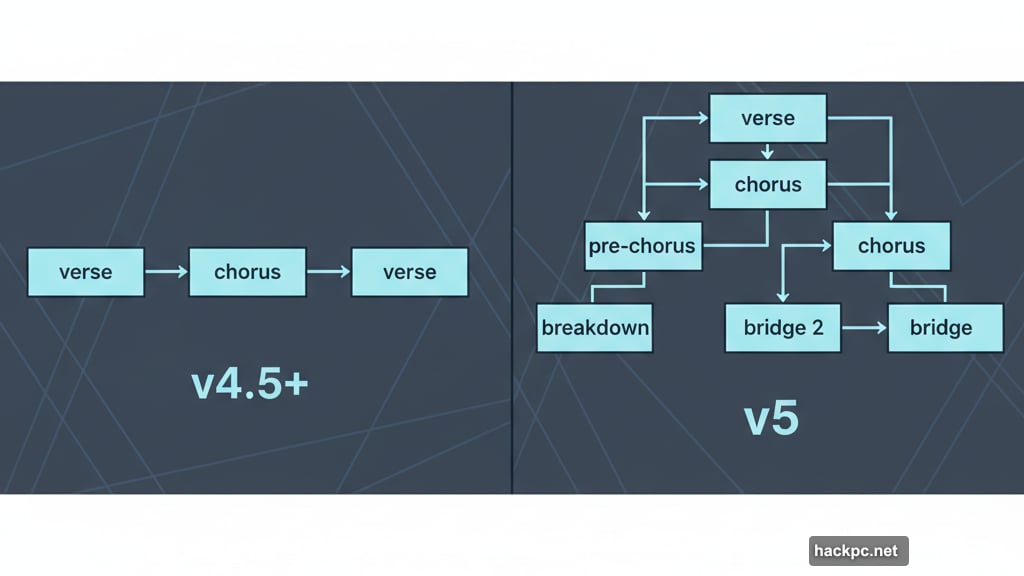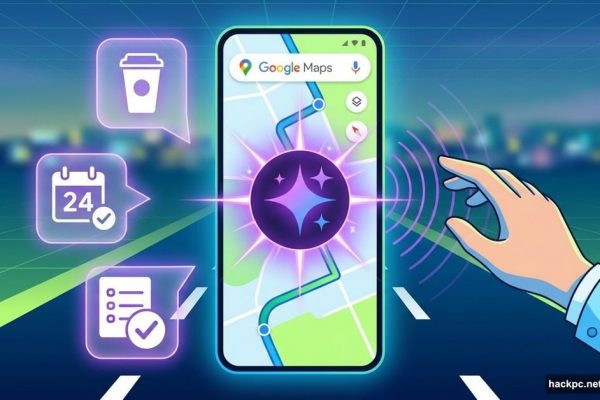
Suno’s latest AI music model creates technically flawless tracks. That’s exactly the problem.
The company’s new v5 model generates cleaner audio, more complex arrangements, and detailed vocal performances. But something crucial is missing. Real emotion doesn’t come from perfect pitch and studio-quality reverb.
It comes from the crack in a singer’s voice. The slightly out-of-tune guitar. The exhausted breath before the final line.
Audio Quality Jumped Forward
The technical improvements are undeniable. V5 produces much cleaner mixes than its predecessor, v4.5+.
Previous versions often smashed instruments together into muddy sonic blobs. Bass, guitar, and synth melted into each other. But v5 keeps everything separated and clear.
During a demo, Suno product manager Henry Phipps pointed out a generated track featuring a flute-like synth with ping-pong delay. “I’ve never heard that before in previous models,” he explained. The AI identified an isolated sound and faithfully reproduced it across different parts of the stereo field.
That’s technically impressive. Suno isn’t actually applying audio effects. Instead, the model decides what effects a particular instrument should have and approximates them.
Genre Understanding Still Falls Short
Suno claims v5 better understands musical genres. Testing reveals a different story.
Take a prompt for “modern avant R&B with glitchy, funky drums and atmospheric melodic parts.” Neither v5 nor v4.5+ nailed it. Both delivered downtempo tracks with moody synths. However, they lacked the experimental weirdness the prompt requested.
Similarly, asking for “early ’90s lo-fi indie rock recorded on a 4-track cassette” produced baffling results. Despite multiple attempts, Suno couldn’t generate anything remotely resembling Pavement’s loose slacker noise pop.
Instead, v5 served up bombastic indie rock with chunky riffs. Think Arctic Monkeys, not Slanted and Enchanted.
Era-specific prompts proved challenging too. When asked for “late 1970s krautrock,” v4.5+ basically nailed it. But v5 often delivered ’80s-tinged synthpop or distinctly modern-sounding tracks.

Arrangements Got More Complex
Here’s where v5 shines. The arrangements are significantly more sophisticated than previous versions.
V4.5+ typically stuck with basic verse-chorus-verse structures. Maybe it threw in a bridge. But v5 creates pre-chorus sections, multiple bridges, breakdowns, and genuine song arcs.
The model adds one-off musical flourishes that prevent repetition. Songs build over time instead of just cycling through distinct sections.
Testing the remix feature produced some interesting surprises. After uploading a track from a personal EP (which probably should have triggered copyright filters), v5 transcribed guitar solo parts into recurring synth motifs. It transformed chord pads into driving arpeggios.
Yet something essential was missing. The raw, lo-fi nature of a living room recording at 3AM disappeared completely.
Vocals Sound Too Perfect
Suno originally promoted v5’s “emotionally rich vocals” and “human-like emotional depth.” That messaging vanished quickly. Now the company describes vocals as “natural, authentic.”
Even that feels generous.
Yes, compared to v4.5+, vocals feel more human. But they’re still painfully stiff and generic. Every rock vocal sounds like Imagine Dragons or Mumford and Sons. Every R&B track resembles a sleepwalking Adele or charmless Ariana Grande.
There are no edges anywhere. Everything gets bathed in reverb, layered with harmonies, and locked to perfect pitch. Even explicit instructions to avoid these elements get ignored.
One test requested an “unprocessed emotional solo A cappella female vocal performance with no reverb, no harmonies, no effects.” The results? Drenched in reverb, backed by harmony vocals, and one track even included what sounded like bass accompaniment.
Phipps acknowledged the limitation. “Models don’t yet understand descriptions of specific effects and recording techniques,” he admitted. Vocal performance gets influenced most by lyrics and general mood.
The Emotion Problem

So here’s a test. Feed Suno lyrics nearly identical to the Rolling Stones’ “Gimme Shelter” (just different enough to avoid copyright flags).
The result had all the surface elements. A powerful female vocalist belting over a full, bluesy arrangement. But it carried the emotional impact of a dentistry textbook.
In the original “Gimme Shelter,” Mary Clayton’s voice cracks as she shouts “rape and murder” during the bridge. That moment is devastating. It’s Robert Smith’s completely out-of-tune warble that conveys desperation in “Why Can’t I Be You.” It’s the tangible exhaustion in Kurt Cobain’s breath before the last line of “Where Did You Sleep Last Night.”
Those imperfections carry emotional weight. They reveal real human struggle and connection.
Making Suno sound “bad” proved impossible. Out of tune, raw, off key, sloppy — the model rejected all of it. For all the talk about “natural” vocals, v5 lacks the imperfections that often matter most.
Suno’s virtual vocalists sound detached. Model v5 might understand that particular lyrics should be sad. But it has no actual emotional connection to the words.
Because it’s code, not an artist.
Technical Mastery Without Soul
The irony cuts deep. Suno got better at mimicking the superficial features of music. Tape hiss, breathing, stereo effects — check, check, check.
But it can’t replicate what makes music actually move people. The vulnerable moments. The imperfect takes artists chose to keep because they felt right. The raw humanity that transcends technical polish.
V5 represents impressive engineering progress. Audio quality improved measurably. Arrangements got more sophisticated. Vocal fidelity increased.
Yet the gap between technical achievement and artistic authenticity widened. The closer Suno gets to sonic perfection, the further it drifts from genuine emotion.
Perfect pitch and flawless mixing don’t create connection. Sometimes the crack in the voice matters more than the note it’s attempting to hit. Sometimes the slightly out-of-tune guitar captures a feeling that precision never could.
Suno built a better music generator. But it still can’t build something that makes you actually feel anything real.



Comments (0)